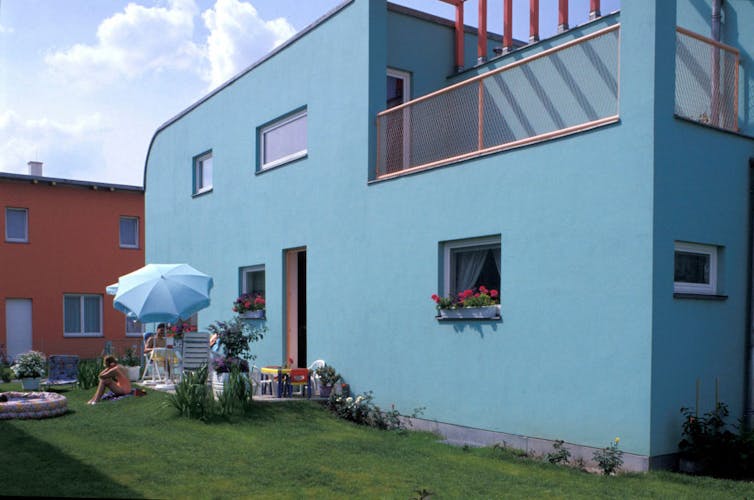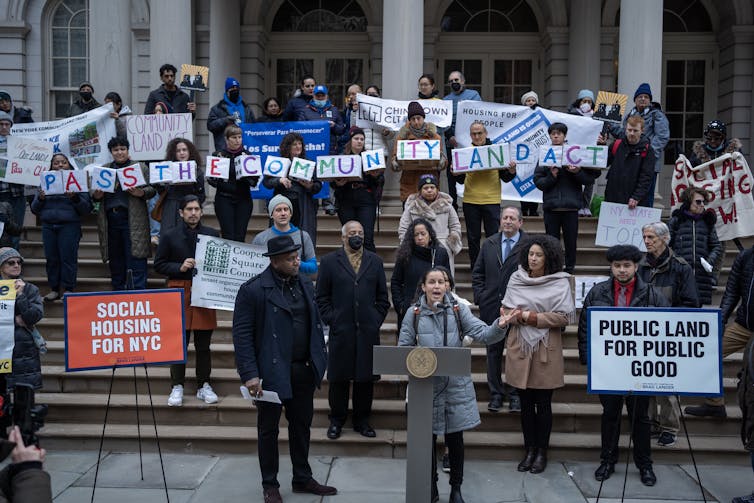Source: The Conversation – USA – By Lisa Schirch, Professor of the Practice of Peace Studies, University of Notre Dame

Every design choice that social media platforms make nudges users toward certain actions, values and emotional states.
It is a design choice to offer a news feed that combines verified news sources with conspiracy blogs – interspersed with photos of a family picnic – with no distinction between these very different types of information. It is a design choice to use algorithms that find the most emotional or outrageous content to show users, hoping it keeps them online. And it is a design choice to send bright red notifications, keeping people in a state of expectation for the next photo or juicy piece of gossip.
Platform design is a silent pilot steering human behavior.
Social media platforms are bringing massive changes to how people get their news and how they communicate and behave. For example, the “endless scroll” is a design feature that aims to keep users scrolling and never reaching the bottom of a page where they might decide to pause.
I’m a political scientist who researches aspects of technology that support democracy and social cohesion, and I’ve observed how the design of social media platforms affects them.
Democracy is in crisis globally, and technology is playing a role. Most large platforms optimize their designs for profit, not community or democracy. Increasingly, Big Tech is siding with autocrats, and the platforms’ designs help keep society under control.
There are alternatives, however. Some companies design online platforms to defend democratic values.
Optimized for profit
A handful of tech billionaires dominate the global information ecosystem. Without public accountability or oversight, they determine what news shows up on your feed and what data they collect and share.
Social media companies say they are in the business of connecting people, but they make most of their money as data brokers and advertising firms. Time spent on platforms translates to profit. The more time you spend online, the more ads you see and the more data they can collect from you.
This ad-based business model demands designs that encourage endless scrolling, social comparison and emotional engagement. Platforms routinely claim they merely reflect user behavior, yet internal documents and whistleblower accounts have shown that toxic content often gets a boost because it captures people’s attention.
Tech companies design platforms based on extensive psychological research. Examples include flashing notifications that make your phone jump and squeak, colorful rewards when others like your posts, and algorithms that push out the most emotional content to stimulate your most base emotions of anger, shame or glee.
Optimizing designs for user engagement undermines mental health and society. Social media sites favor hype and scandal over factual accuracy, and public manipulation over designing for safety, privacy and user agency. The resulting prevalence of polarizing false and deceptive information is corrosive to democracy.
Many analysts identified these problems nearly a decade ago. But now there is a new threat: Some tech executives are looking to capture political power to advance a new era of techno-autocracy.
Optimized for political power
A techno-autocracy is a political system where an authoritarian government uses technology to control its population. Techno-autocrats spread disinformation and propaganda, using fear tactics to demonize others and distract from corruption. They leverage massive amounts of data, artificial intelligence and surveillance to censor opponents.
For example, China uses technology to monitor and surveil its population with public cameras. Chinese platforms like WeChat and Weibo automatically scan, block or delete messages and posts for sensitive words like “freedom of speech.” Russia promotes domestic platforms like VK that are closely monitored and partly owned by state-linked entities that use it to promote political propaganda.
Over a decade ago, tech billionaires like Elon Musk and Peter Thiel, and now Vice President JD Vance, began aligning with far-right political philosophers like Curtis Yarvin. They argue that democracy impedes innovation, favoring concentrated decision-making in corporate-controlled mini-states governed through surveillance. Embracing this philosophy of techno-autocracy, they moved from funding and designing the internet to reshaping government.
Techno-autocrats weaponize social media platforms as part of their plan to dismantle democratic institutions.
The political capture of both X and Meta also have consequences for global security. At Meta, Mark Zuckerberg removed barriers to right-wing propaganda and openly endorsed President Donald Trump’s agenda. Musk changed X’s algorithm to highlight right-wing content, including Russian propaganda.
Designing tech for democracy
Recognizing the power that platform design has on society, some companies are designing new civic participation platforms that support rather than undermine society’s access to verified information and places for public deliberation. These platforms offer design features that big tech companies could adopt for improving democratic engagement that can help counter techno-autocracy.
In 2014, a group of technologists founded Pol.is, an open-source technology for hosting public deliberation that leverages data science. Pol.is enables participants to propose and vote on policy ideas using what they call “computational democracy.” The Pol.is design avoids personal attacks by having no “reply” button. It offers no flashy newsfeed, and it uses algorithms that identify areas of agreement and disagreement to help people make sense of a diversity of opinions. A prompt question asks for people to offer ideas and vote up or down on other ideas. People participate anonymously, helping to keep the focus on the issues and not the people.
Taiwan used the Pol.is platform to enable mass civic engagement in the 2014 democracy movement. The U.K. government’s Collective Intelligence Lab used the platform to generate public discussion and generate new policy proposals on climate and health care policies. In Finland, a public foundation called Sitra uses Pol.is in its “What do you think, Finland?” public dialogues.
Barcelona, Spain, designed a new participatory democracy platform called Decidim in 2017. Now used throughout Spain and Europe, Decidim enables citizens to collaboratively propose, debate and decide on public policies and budgets through transparent digital processes.
Nobel Peace Laureate Maria Ressa founded Rappler Communities in 2023, a social network in the Philippines that combines journalism, community and technology. It aims to restore trust in institutions by providing safe spaces for exchanging ideas and connecting with neighbors, journalists and civil society groups. Rappler Communities offers the public data privacy and portability, meaning you can take your information – like photos, contacts or messages – from one app or platform and transfer it to another. These design features are not available on the major social media platforms.

Screenshot of Rappler Communities
Tech designed for improving public dialogue is possible – and can even work in the middle of a war zone. In 2024, the Alliance for Middle East Peace began using Remesh.ai, an AI-based platform, to find areas of common ground between Israelis and Palestinians in order to advance the idea of a public peace process and identify elements of a ceasefire agreement.
Platform designs are a form of social engineering to achieve some sort of goal – because they shape how people behave, think and interact – often invisibly. Designing more and better platforms to support democracy can be an antidote to the wave of global autocracy that is increasingly bolstered by tech platforms that tighten public control.
![]()
Lisa Schirch receives funding from the Ford Foundation. I know the founder of Pol.is and Remesh platforms, mentioned in this article, as well as Maria Ressa of Rappler Communities.
I will not benefit in any way from describing their work.
– ref. Social media can support or undermine democracy – it comes down to how it’s designed – https://theconversation.com/social-media-can-support-or-undermine-democracy-it-comes-down-to-how-its-designed-257103

















